BASEBALL ON TOUR ... WESTERN CANADA HOSTS MAJOR LEAGUERS
AND SAWAMURA ... THE BABE A CELEBRITY IN JAPAN
By Redeye Ropertz
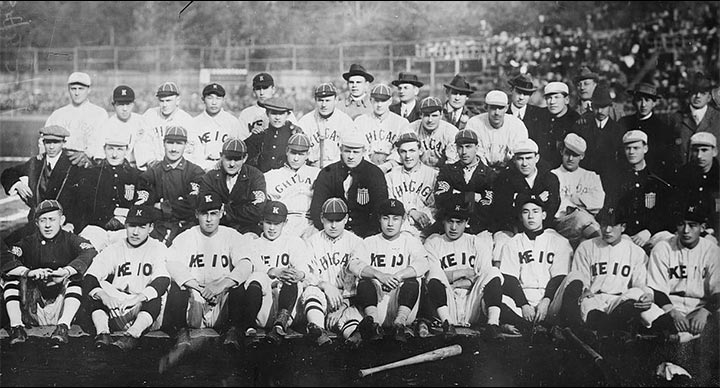
As an incidental outgrowth of an attempt by American missionaries to bring Christianity to the Far East, baseball was introduced in Japan in the 1860s.
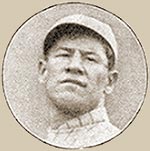 A 1908 tour by a team, mainly of Pacific Coast League players and organized by the A. J. Reach Company, is believed to be the first by an American squad.
A 1908 tour by a team, mainly of Pacific Coast League players and organized by the A. J. Reach Company, is believed to be the first by an American squad.
In 1913, as part of a world tour, the Chicago White Sox and the New York Giants set foot in the Land of the Rising Sun and delighted their first ever all-Nipponese audience with their level of skill during a single exhibition encounter (see photo above). Yes, that's John McGraw, second row up, sixth from the left. Among the Giants, a famous American athlete, Jim Thorpe (left).
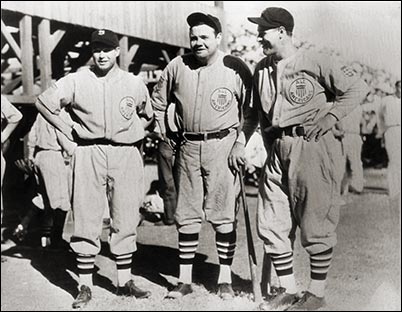 It was not until eleven years later, however, that touring American major leaguers returned. This time the lineup included well-known impact players such as Casey Stengel, Luke Sewell and Bob Meusel.
It was not until eleven years later, however, that touring American major leaguers returned. This time the lineup included well-known impact players such as Casey Stengel, Luke Sewell and Bob Meusel.
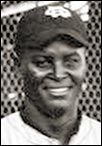 In 1927, the Philadelphia Royal Giants, a squad of Negro players, including star catcher Biz Mackey (right), took the hop to Japan and won 23 of 24 games. In the process they cranked out a barrage of long distance home runs, some clearing the fences. The nickname "Giants" became synonymous with "respect" and "superiority".
In 1927, the Philadelphia Royal Giants, a squad of Negro players, including star catcher Biz Mackey (right), took the hop to Japan and won 23 of 24 games. In the process they cranked out a barrage of long distance home runs, some clearing the fences. The nickname "Giants" became synonymous with "respect" and "superiority".
 "The Georgia Peach", Ty Cobb, was part of an American All-Star trek in 1928 while Lou Gehrig and Robert Moses "Lefty' Grove (right, on the cover of a game program) led a 1931 tour of Japan as the barnstorming junkets continued to increase in popularity. The 1934 series featured the incomparable George Herman "Babe' Ruth (seen above with fellow All-Stars, Jimmie Foxx (left) and Lou Gehrig). Even with declining skills, the Babe remained baseball's most entertaining and sought-after star.
"The Georgia Peach", Ty Cobb, was part of an American All-Star trek in 1928 while Lou Gehrig and Robert Moses "Lefty' Grove (right, on the cover of a game program) led a 1931 tour of Japan as the barnstorming junkets continued to increase in popularity. The 1934 series featured the incomparable George Herman "Babe' Ruth (seen above with fellow All-Stars, Jimmie Foxx (left) and Lou Gehrig). Even with declining skills, the Babe remained baseball's most entertaining and sought-after star.
Interestingly, the purpose of these trips was not cultural but economic. Ball players were poorly paid and required off season exhibition games to supplement their income.
Prior to sailing to Japan in 1934, the 36 American League All-Stars split into two camps. One squad, led by the 1933 home run champion Jimmie Foxx, toured Western Canada playing in cities such as Winnipeg, Saskatoon, Regina, Edmonton, Calgary and Vancouver. They played 12 games on Canadian soil winning 10 of 11 decisions, with one tie. The contingent led by Babe Ruth took the Soo Line Railway out of Chicago and travelled through Minnesota, North Dakota and Western Canada. Ruth was treated as a celebrity wherever the train stopped, be it Fargo, North Dakota or Estevan, Saskatchewan. His charisma was unmatched by any other athlete of his time.
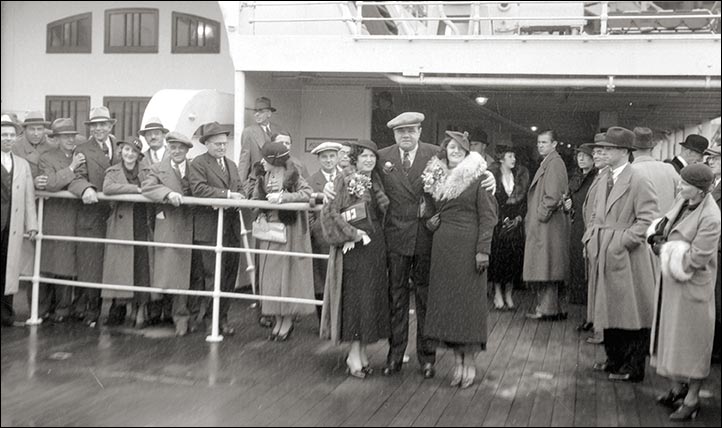
The 1934 tour was organized by former New York Giant batting champion, Francis "Lefty" O'Doul and Sotaro Suzuki, a Japanese baseball writer, in partnership with the Canadian Pacific Railway (C.P.R.). On a journey from Tokyo to New York, Suzuki landed in Vancouver and embarked upon a train ride to Montreal. He was so impressed with the majestic and pristine scenery, which included Lake Louise, that he concluded this had to be a major part of the reason why Americans and Canadians seemed so composed and serene while Japanese appeared to be more high-strung. How this theory impacted Japanese baseball is uncertain.
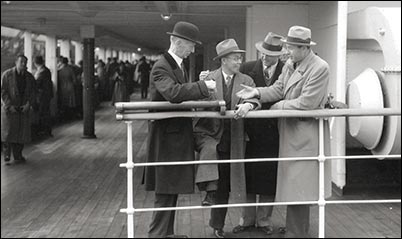 The arrangement with the Canadian railway meant the American League All-Stars would travel on C.P.R. trains, sleep in its majestic hotels and cross the Pacific Ocean aboard its massive 26,000 tonne flagship "The Empress of Japan".
The arrangement with the Canadian railway meant the American League All-Stars would travel on C.P.R. trains, sleep in its majestic hotels and cross the Pacific Ocean aboard its massive 26,000 tonne flagship "The Empress of Japan".
Suzuki is 2nd from the left, O'Doul on the right, with Connie Mack (left) and probably umpire John Quinn as the team set sail for Japan.
Connie Mack and his son Earle had assembled a cast of American League All-Stars featuring not only Babe Ruth but five more future Hall of Famers, including Jimmie Foxx, Charlie Gehringer and Lou Gehrig. It was the appearance of the 39-year-old Ruth which made this tour the most successful, not only in gate receipts, but also in  celebration and genuine friendliness. Everywhere the Babe went he drew massive crowds. Despite heated tensions between the United States and Japan, the Babe was treated as a celebrity.
celebration and genuine friendliness. Everywhere the Babe went he drew massive crowds. Despite heated tensions between the United States and Japan, the Babe was treated as a celebrity.
Following the 19-game warm-up tour in 15 cities in Canada and the United States, the All American squad played 23 games in four countries on their Asian tour and won all of them, many by lop-sided scores. There was such a demand for tickets that organizers incredulously charged prices double and even triple the average cost of a baseball ticket at Fenway Park or Yankee Stadium. All games were virtually sold out and attendance at some matches approached 100,000. No stadium in either the American or National League could accommodate such crowds. Total attendance for the entire trip exceeded 500,000.
There was no professional baseball in Japan and finding suitable opposition to face such accomplished stars as Babe Ruth and Lou Gehrig was a major problem. The better players in Japan played at the University level and would lose their amateur status if they played against professionals. For years, Japanese universities had been sending players to North America to gain experience, playing against semi-pro and amateur teams. In 1911, Waseda University traveled all the way to Vancouver and beat the 1910 Vancouver Senior A League champions by the score of 4 - 0. The challenge for media moguls, such as Sotaro, who were hoping the series would boost newspaper sales, was to convince the better university players to participate in this "historic" tour. A number of the more accomplished students did play and many of them stayed with the team the following year. Although not the first professional team in Japan, the newly formed Dai Nippon Tokyo Yakyu Club (Greater Tokyo Baseball Team) would lay the foundation for professional baseball in the country. It is not surprising that they would adopt the nickname "Giants". Lefty O'Doul, long time friend and passionate supporter of baseball in Japan, played for the New York Giants.
Babe Ruth played in every game, hitting 13 home runs, scoring 27, driving in 33 more, while batting .408 -- a triple crown achievement. The 1934 tour turned out to be more than just a series of friendly exhibitions. It was an event that changed lives, was a diplomatic coup, and significantly influenced Japanese baseball. It was also Babe Ruth's farewell tour and he went out with a bang! In effect, Babe Ruth almost single-handedly globalized the game of baseball when baseball was still just a game.
By the end of the 1934 tour the Major Leagues had compiled an overall record of 87 - 1! The only loss coming in 1922 when Keio University Alumni defeated the American visitors 9 - 3.

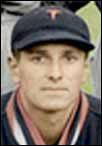 In 1935, the Tokio Giants undertook an extensive four month barnstorming tour of both the United States and Canada. In all, they played 109 games, winning 74.
In 1935, the Tokio Giants undertook an extensive four month barnstorming tour of both the United States and Canada. In all, they played 109 games, winning 74.
Baseball fans from Winnipeg to Vancouver would soon marvel at the talent of some of these young phenoms such as Eiji Sawamura (left, who appeared in nearly half of the games and finished with a 24-9 record) and Russian born Victor Starffin (right). Nine members of the team would ultimately make the Japanese Baseball Hall of Fame.
The years 1934 and 1935 were exciting, historic and memorable times to be a baseball fan in Western Canada. Not only did fans have the opportunity to watch some of the best ball players in history, they were witness to the emergence of Japanese professional baseball.
AMERICAN LEAGUE ALL-STARS TOUR OF WESTERN CANADA 1934 GAME REPORTS
AMERICAN LEAGUE ALL-STARS TOUR OF JAPAN 1934 GAME REPORTS
TOYKO GIANTS BARNSTORMING TOUR OF WESTERN CANADA 1935 GAME REPORTS
